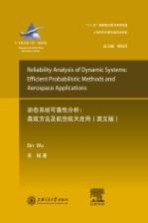

动态系统可靠性分析 高效方法及航空航天应用 英文版PDF电子书下载
- 电子书积分:10 积分如何计算积分?
- 作 者:吴斌著
- 出 版 社:上海:上海交通大学出版社
- 出版年份:2013
- ISBN:9787313101709
- 页数:202 页
1.Introduction 1
1.1 Structural Reliability Analysis 1
1.2 Non-deterministic Reliability Analysis Methods 6
1.2.1 Monte Carlo Simulation(MCS)Method 6
1.2.2 FORM(First-order Reliability Method) 7
1.2.3 Interval Analysis 9
1.2.4 Fuzzy Analysis 10
1.2.5 Response Surface Method(RSM) 11
1.2.6 Summary 12
1.3 Uncertainty Analysis of Dynamic Systems 13
1.3.1 Background 13
1.3.2 Literature Review of Analytical Approaches to Dynamic Systems 15
1.3.3 Summary 22
1.4 Scope of the Present Work 23
1.5 Overview of the Book 23
2.Technical Background 25
2.1 Definition of Structural Reliability 25
2.2 Technical Basis of the Monte Carlo Simulation Method 26
2.3 Theory of the First-order Reliability Method(FORM) 30
2.4 Response Surface Method 34
2.4.1 Response Surface Models and Fitting Techniques 34
2.4.2 Sampling Design Methods 36
2.5 Problems of Applying FORM and RSM Methods to Dynamic Systems 39
2.5.1 Problematic Failure Surfaces for FORM Applications 39
2.5.2 Inaccuracy of RSM in Predicting the Dynamic Response 40
2.6 Optimization Solution Through Modal Analysis 41
3.Theoretical Fundamentals of the Perturbation Approach 43
3.1 Definition of the New Parameters and Safety Margin 43
3.2 Derivation of the Two Moments of the New Parameters 47
3.2.1 Derivation of the Covariance Matrix of the Modal Parameter ω2 48
3.2.2 Derivation of the Covariance Matrix of the Defined Parameter dr 52
3.2.3 Derivation of the Covariance Matrix of the Modal Parameter[Ф] 54
3.2.4 Derivation of the Covariance Matrix of the Defined Parameter rjk,r 58
3.2.5 Derivation of the Covariance Matrix of the Combined Parameter T 62
3.2.6 Derivation of the Mean Values of the Defined Parameters dr and rjk,r 63
3.3 Application Procedure of the New Approach 64
3.4 Discussion 65
3.5 Summary 66
4.Application to a 2D System 69
4.1 Finite Element Model of a 2D Dynamic System 69
4.2 Applying the Combined Approach:Preliminary Analysis 74
4.2.1 Response Analysis 76
4.2.2 Safety Margin Contour 78
4.3 Perturbation Approach+FORM Method 81
4.3.1 Evaluating the Probability of Failure and In-depth Analysis 81
4.3.2 Solution 1:Second-order Approximation of d2 89
4.3.3 Solution 2:New Variable e2 to Replace d2 101
4.3.4 Solution 3:Variable ω2 2 to Replace e2 104
4.4 Solution 4:Monte Carlo Simulation Replacing FORM 111
4.4.1 Perturbation+Monte Carlo Simulation on r2 and ω2 2 112
4.4.2 Reliability Analysis of the Updated Combined Approach 113
4.5 Summary 116
5.Application to a 3D Helicopter Model 119
5.1 Background of Helicopter Vibration Control 119
5.2 A 3D Helicopter FE Model 120
5.2.1 System Details 120
5.2.2 Dynamic Characteristics of the Model 123
5.3 Response Analysis 128
5.4 Reliability Analysis of the Combined Approach 129
5.4.1 Probability vs.Excitation Frequencies 129
5.4.2 Probability vs.Maximum Displacement and Variation Coefficient 132
5.5 Efficiency Analysis 135
5.6 Summary 137
6. Complete Combined Approach 141
6.1 Response Surface Techniques in Obtaining Ck 141
6.1.1 Direct RS Model Fitting of the Stiffness Matrix K 141
6.1.2 Alternative Fitting Approach 143
6.1.3 Analytical Approach to Obtain the Covariance Matrix of K 147
6.1.4 Complete Combined Approach 149
6.2 Complete Application to 2D Frame Model 149
6.2.1 Type I RS Model Fitting with Koshal Design 149
6.2.2 Complete Combined Approach 151
6.3 Complete Application to 3D Helicopter Model 155
6.4 Summary 157
7. Conclusions and Future Work 159
7.1 Achievements and Conclusions 159
7.2 Future Work 160
7.2.1 Application of an Enhanced FORM Method 161
7.2.2 Further Simplification of Perturbation/Analytical Algorithms 163
7.2.3 Development for Non-Probabilistic Methods 163
Appendix Ⅰ:Transforming Random Variables from Correlated to Uncorrelated 165
Appendix Ⅱ:Analytical Solution of HL Safety Index 167
Appendix Ⅲ:Modal Analysis of Dynamic Systems 169
Appendix Ⅳ:Multiple Force Analysis 173
Appendix Ⅴ:Summary of the Defined Parameters 179
Appendix Ⅵ:Nodal Coordinates of the Helicopter Model 185
Appendix Ⅶ:Element Connectivity and Properties of the Helicopter Model 187
References 191
Index 199
- 《卓有成效的管理者 中英文双语版》(美)彼得·德鲁克许是祥译;那国毅审校 2019
- 《AutoCAD 2018自学视频教程 标准版 中文版》CAD/CAM/CAE技术联盟 2019
- 《跟孩子一起看图学英文》张紫颖著 2019
- 《AutoCAD机械设计实例精解 2019中文版》北京兆迪科技有限公司编著 2019
- 《复分析 英文版》(中国)李娜,马立新 2019
- 《张世祥小提琴启蒙教程 中英文双语版》张世祥编著 2017
- 《生物化学 本科临床 英文版》张晓伟 2018
- 《理想国 全英文原版》(古希腊)柏拉图著 2017
- 《Dreamweaver CC 2018标准实例教程 中文版》杨雪静,胡仁喜编著 2019
- 《Flash CC动画制作实用教程 中文版》麓山文化 2019
- 《中风偏瘫 脑萎缩 痴呆 最新治疗原则与方法》孙作东著 2004
- 《水面舰艇编队作战运筹分析》谭安胜著 2009
- 《王蒙文集 新版 35 评点《红楼梦》 上》王蒙著 2020
- 《TED说话的力量 世界优秀演讲者的口才秘诀》(坦桑)阿卡什·P.卡里亚著 2019
- 《燕堂夜话》蒋忠和著 2019
- 《经久》静水边著 2019
- 《魔法销售台词》(美)埃尔默·惠勒著 2019
- 《微表情密码》(波)卡西亚·韦佐夫斯基,(波)帕特里克·韦佐夫斯基著 2019
- 《看书琐记与作文秘诀》鲁迅著 2019
- 《酒国》莫言著 2019
